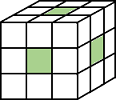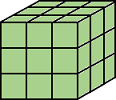bwlabeln
对二值图像中的连通分量加标签
说明
示例
输入参数
输出参量
提示
此函数根据每个分量的
top-left极值从左到右对连通分量进行排序。当多个分量具有相同的水平位置时,该函数先从上到下对这些分量进行排序,然后沿任何更高的维度进行排序。下图显示了两个不同的二维区域的极值。函数
bwlabel、bwlabeln和bwconncomp都计算二值图像的连通分量。bwconncomp使用的内存少得多,有时运行速度比其他函数更快。函数 输入维度 输出格式 内存使用量 连通性 bwlabel二维 双精度标签矩阵 高 4 或 8 bwlabelnN 维 双精度标签矩阵 高 任何 bwconncompN 维 CC结构体低 任何 要使用具有默认连通的
regionprops从二值图像中提取特征,请使用命令regionprops(BW)将BW直接传入regionprops。
参考
[1] Sedgewick, Robert, Algorithms in C, 3rd Ed., Addison-Wesley, 1998, pp. 11-20.
扩展功能
版本历史记录
在 R2006a 之前推出另请参阅
bwconncomp | bwlabel | labelmatrix | label2rgb | regionprops




